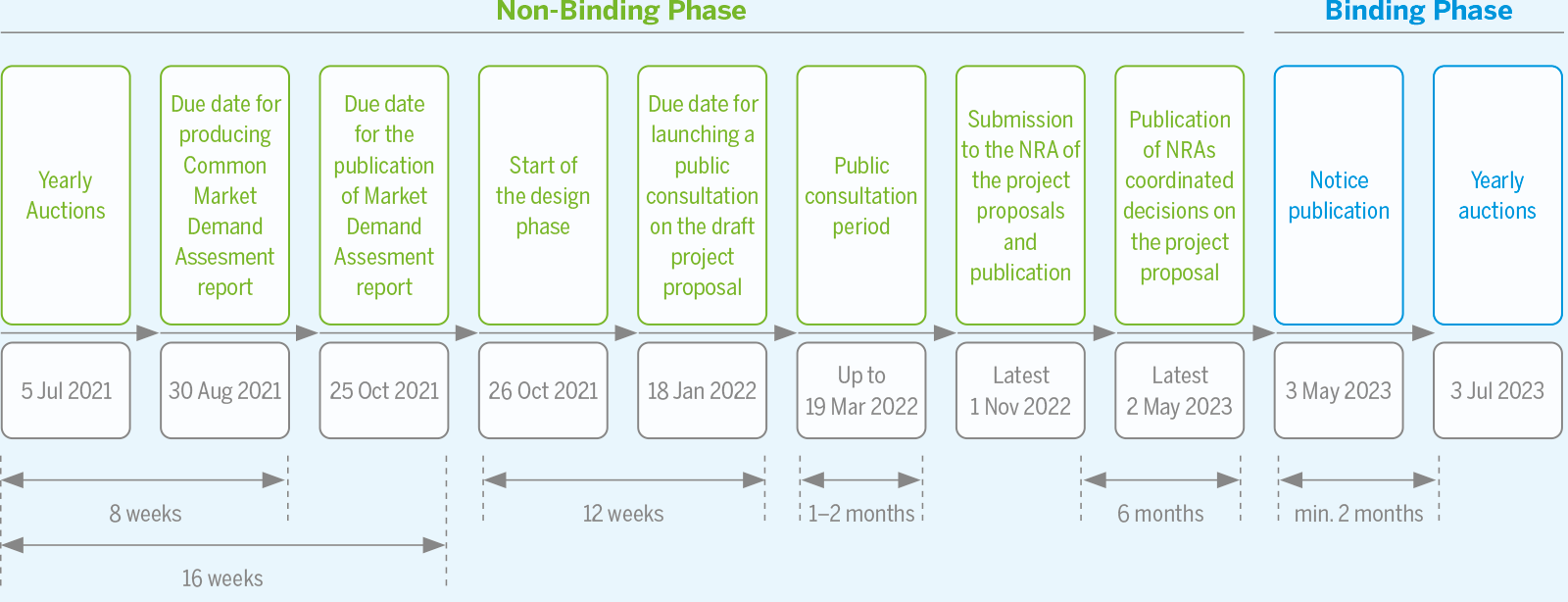Picture courtesy of Teréga
8 Incremental Capacity process
The incremental capacity process has been introduced by the EC Regulation (EU) 2017/4591 as a streamlined and harmonised Union-wide process to react to possible market-based capacity requests for an increase in technical capacity or creation of new capacity.
1 COMMISSION REGULATION (EU) 2017/459 of 16 March 2017 establishing a network code on capacity allocation mechanisms in gas transmission systems and repealing Regulation (EU) No 984/2013
The requested incremental capacity is offered based on a market demand. Technical capacity is increased at an existing IP or through establishing a new IP or creating a physical reverse flow capacity at an IP, which has not been offered before, only if there are binding market commitments and subject to the positive outcome of an economic test.
The aim of setting rules for incremental capacity is to identify the need for new/incremental capacity and to allocate both existing and incremental capacity in an integrated way.
The process lasts two years and is divided in two phases, a non-binding phase in which the demand for incremental capacity is assessed, and a binding phase where network users provide binding commitments for incremental capacity.
The non-binding phase
The non-binding phase starts after the annual yearly auction, at least in each odd-numbered year, with the assessment of demand indications for incremental capacity. The network users provide TSOs with their non-binding capacity demand. No later than eight weeks after the start of the annual yearly auction, TSOs TSOs are required to produce market demand assessment reports (DARs) to be published within 16 weeks after the start of the annual yearly auction. The DARs should consider, among other things, whether the TYNDP identifies a physical capacity gap whereby a specific region is undersupplied in a reasonable peak scenario and where offering incremental capacity at the interconnection point in question could close the gap; or a national network development plan identifies a concrete and sustained physical transport requirement. If the DAR identifies demand for incremental capacity that cannot be satisfied by existing available capacity, the concerned TSOs will follow the incremental capacity process further. If no demand has been identified, the process stops at that point.
The design phase
In the next phase, the design phase, TSOs conduct technical studies for incremental capacity projects and coordinated offer levels based on technical feasibility and the DARs. A public consultation on the key parts of the draft project proposal is conducted and stakeholders have an opportunity to provide feedback on the TSOs’ proposals. A key milestone after the design phase and public consultation is to submit a comprehensive incremental capacity project proposal to the relevant National Regulatory Authorities (NRAs). The NRAs will then have six months to issue coordinated decisions on the project proposal.
The allocation phase
After receiving binding commitments for the incremental capacity offered in the annual yearly auction, the economic viability of the incremental capacity project will be assessed trough the economic test. If the outcome of the economic test is positive on both sides of an interconnection point for at least one offer level that includes incremental capacity, an incremental capacity project will be initiated.
8.1 Incremental capacity process initiated in 2021

Figure 48: Timeline for the incremental capacity process initiated in 2021
The beginning of the process for 2021 has been marked by the development and publication of the DARs. Start of the design phase, due to received market interest, has been triggered on six borders which is shown in table 8.
| TYNDP 2022 Project Code | Description | Entry-exit border | TSO(s) involved in DAR | Gas flow direction covered by Demand Indications |
|---|---|---|---|---|
| BELUX – DE | Fluxys Belgium, Fluxys TENP, GASCADE, Open Grid Europe, Thyssengas, Creos Luxembourg | only entry DE | ||
| Polish – Czech Interconnection DAR 2021 (not submitted into TYNDP 2022)1 | CZ – PL | NET4GAS, GAZ-SYSTEM2 | Exit PL / entry CZ | |
| TRA-F-378 TRA-N-1112 | Interconnector Greece – Bulgaria (IGB Project) Upgrade of Compressor Station at Komotini | GR – ICGB (GR) | DESFA, ICGB | exit GR / entry ICGB (GR) |
| TRA-A-971 TRA-A-810 TRA-N-1195 | Booster Compressor Station for TAP in Nea Messimvria TAP Expansion Matagiola – Massafra pipeline | GR – TAP – IT | DESFA, TAP, Snam Rete Gas S.p.A.3 | exit GR / entry TAP exit TAP / entry IT |
| PL – UA | GAZ-SYSTEM, LLC Gas TSO of Ukraine4 | exit PL / entry UA | ||
| UA – RO | LLC Gas TSO of Ukraine, Transgaz | entry UA / exit RO, “Bidirectional” for IP Tekove/Medieșu Aurit |
1 Incremental project Polish-Czech Interconnection DAR 2021 has not been submitted due to its initiation after the completion of the TYNDP 2022 projects data collection first phase. During the second extraordinary phase of projects data collection the PL – CZ incremental project was not submitted due to not finished discussion related to its final parameters.
2 The project initiated by MDAR conducted by respective TSOs in 2021 was designed as one-directional (from PL to CZ) incremental capacity at the existing IP Cieszyn. (The capacity in the reverse direction – from CZ to PL – is already on the place.) This project was consulted with the market in January – March 2022. Both TSOs are still discussing the final parameters of the project. It has not been yet submitted for approval and for the moment concrete submission date is not known.
3 “The three Transmission System Operators, Trans Adriatic Pipeline AG (TAP), SNAM Rete Gas (SRG) and DESFA, submit to the National Regulatory Authorities of Greece, Italy and Albania, a Project Proposal for an incremental capacity project, in accordance with Regulation (EU) 2017/459. The Project Proposal for the incremental capacity project was approved by the relevant NRAs.”
4 PL – UA INC project was submitted in November to both NRAs.
Table 8: Projects for which a demand for incremental capacity was identified in the DARs
In two cases, where there was no interest received during the 2021 incremental process, the process commenced in 20192 will continue.
For TYNDP 2022 ENTSOG collected information regarding projects triggered by the Incremental Capacity process. For natural gas projects the provision of such information was mandatory.
It should be noted that project data collection for TYNDP 2022 took place in two stages: first stage of project collection was in November 2021 and the extraordinary additional second phase was in June 2022 due to EC’s REPowerEU Communication. At that time, the process reached a stage at which most TSOs receiving non-binding interest at the demand assessment phase, have submitted project proposals to their NRAs.
2 For the HU – SI border – involved TSOs FGSZ and Plinovodi, provided the terms currently disagreed could be mutually agreed by all concerned TSOs and NRAs, and IT – SI border – involved TSOs Snam and Plinovodi;
The General Court of the European Union ruling on the incremental capacity process
On 16 March 2022, the General Court of the European Union (“the Court”) issued a ruling involving FGSZ, MEKH, E-Control, ACER and the EC. In its ruling3, the Court declares Chapter V of Regulation 2017/459 (CAM NC) inapplicable under Article 277 TFEU, as the EC was not legally entitled to adopt rules on incremental capacity.
According to the Court, the Gas Regulation did not empower the EC to adopt the provisions governing the incremental capacity process of chapter V of the CAM NC. While the judgement does not have erga omnes effect4, it will be up to the EC, to eventually develop new harmonised rules for the incremental capacity (Art 266 TFEU).
3 https://curia.europa.eu/juris/document/document.jsf?docid=256001&mode=lst&pageIndex=1&dir=&occ=first&part=1&text=&doclang=EN&cid=7186955
4 Latin: “towards all” or “towards everyone”. In legal terminology, erga omnes rights or obligations are owed toward all.

